Constructing An Aquaculture Pond
I spoke briefly about aquaculture pond construction on Day 17, discussing various forms of water catchment on your property, but today we’re going to get into the details of it…
The minimum recommended size for an optimally producing, 100%-self-sufficient pond is 300 square meters (1/13th of an acre or 57×57 feet).
Square or circle shapes are less productive than odd amoeba shapes, thanks to the edge effect (see diagram) but smaller ponds can be equally productive per unit of size if you supplement them with a few outside inputs. Utilize the land energy at your disposal more fully by getting fish that will eat earth-based vegetation, increasing the efficiency of your edge effect.
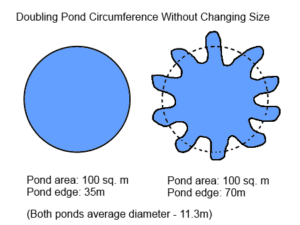 Likewise, multiple smaller ponds are more productive than one large pond (again, thanks to the edge effect), which can allow you to stagger harvesting to provide year-round fresh fish as opposed to one huge harvest (which can be difficult to process and eat or sell in one go).
Likewise, multiple smaller ponds are more productive than one large pond (again, thanks to the edge effect), which can allow you to stagger harvesting to provide year-round fresh fish as opposed to one huge harvest (which can be difficult to process and eat or sell in one go).
In fact, even the smallest garden can benefit from even micro ponds, which provide moisture and habitats for friendly pest-eaters like frogs, mosquito-eating guppies, and other goldfish.
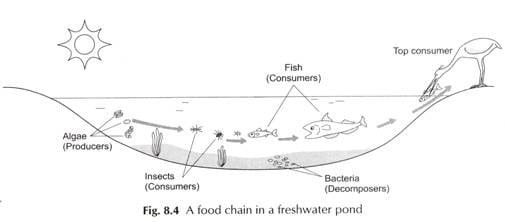
The chain of life in an aquatic system is:
Algae > Zooplankton (tiny organisms that break down the organic matter) >> Crustaceans (shrimp, crayfish, etc., feed on zooplankton) >>> Fish (eat the crustaceans and other smaller organisms) >>>> Above-Water Predators.
The aquatic plants in your system will all naturally live at different levels in the pond, including:
- Emergent plants: These grow in up to 2 feet of water but have leaves and flower above the water.
- Floating plants: These sit on top of the water, and their roots are not connected to the water bed. Floating plants are great cleaners of wastes and sediment and can provide fish feed, shelter, and protection for your various organisms, plus many are edible and can also make great mulch for other crops.
- Land plants: Grown on the banks, it’s best to raise crops that can be used as fish and duck feed; these can benefit from the excess mulch from the pond.
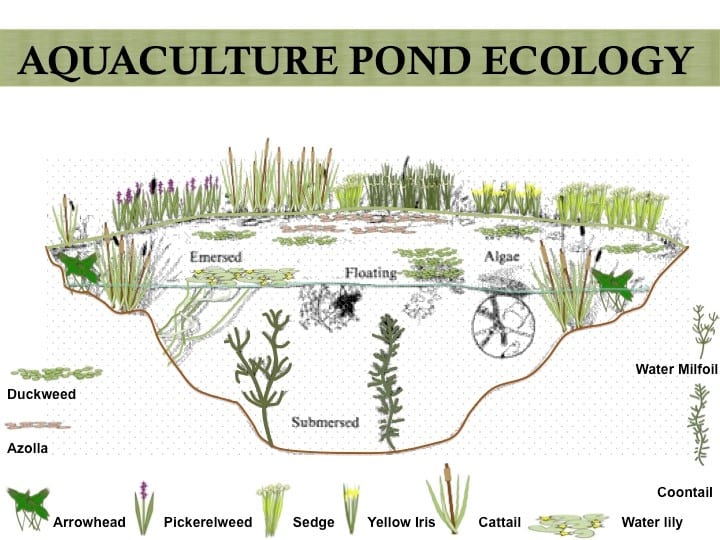
Many of these plants clean the water and provide food for the fish and other creatures, but it’s often best to decide which fish species you want to farm and then design your feed-crop system around their needs.
Some of the most useful plants to populate your pond with include:
- Asian Lotus: Its roots can be eaten and its flowers can fetch a high price in markets.
- Duckweed and Water Hyacinth: Both are great animal feeds and can also be consumed by humans.
- Rice: One of the staple foods of the world, wild rice plants can be continually harvested over a month-long period by shaking them daily. A single plant can produce a whole pound of rice!
- Water Spinach: Leaves and shoots can be used as vegetables (tropical and subtropical).
- Chinese Water Chestnut: One of the heaviest yielding plants in the world, grown for their crisp delicate root corms and high starch content.
- Taro: Heavy yielding with a starchy root and edible leaves; grows best in shallow water and on water lines.
Check with your local agricultural extension office or through local growers’ forums for lists of the aquatic plants best suited for your area and climate; also remember some of the fish mentioned may not be permitted in your country or area.
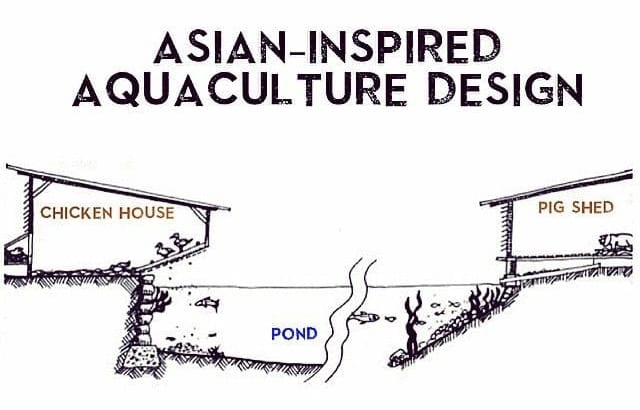
and pig waste to fertilize the pond
How Many Fish To A Pond?
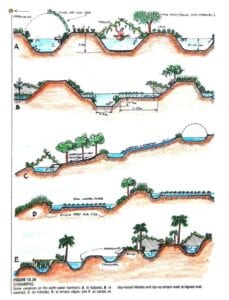 Without aeration equipment you can safely stock (accommodate) fish at a rate of 1 kg of live weight per 1 cubic meter of pond water.
Without aeration equipment you can safely stock (accommodate) fish at a rate of 1 kg of live weight per 1 cubic meter of pond water.
With aeration, you can stock at rates up to 25 to 30 kg per cubic meter. Rates of up to 150 kg per cubic meter of water have been achieved, but this is at the extreme end of scale and requires major biofiltration.
When you’re just getting started, fingerlings (baby fish) are usually inexpensive and can be purchased from your local supplier.
Once you’re more experienced and have had a bit of training on fish breeding, you can try to breed your own. Bloodstock (or broodfish) are a group of mature fish kept in captivity and used for breeding purposes; you can buy them from suppliers. You can even experiment with breeding from wild caught fish if you’re up for a fun challenge.
You can grow your fish in baskets or net cages that have been dropped into the pond (and attached to land), protecting them and allowing for easy harvest while still giving them free access to all the pond nutrients.
Alternatively, you can choose not to fully harvest your fish each harvest cycle and allow the pond’s population to restock itself the old-fashioned way. This will significantly reduce your yearly harvest but means the least amount of effort in terms of annual pond maintenance.
Harvesting is best done at the end of the cycle by draining the pond, but nets can be used at any time.
What Kind Of Fish Is For You?
Your climate dictates what types of fish you can farm outdoors…
Carp, tilapia, catfish, and trout are the most farmed freshwater fish in the world, but they all have their various preferences, so you can’t necessarily farm all of them in the same climate or with the same feed stuffs. Trout, for example, are cool-water carnivores with specific dietary requirements, meaning you’ll need to either buy expensive feed for them or spend more time on feed production.
If you’re in a predominantly cool climate, you’ve got lots of options. Carp, trout, catfish, bass, white and yellow perch, crawfish, freshwater prawns, and freshwater sturgeon will all do well for you.
Tilapia are one of the fastest growing, low-oxygen tolerating, hardiest fish that can be used in aquaculture. They’ll do well for you if you’ve got a warmer climate.
If you live in the desert or drylands, make your ponds smaller and deeper, and grow shade plants and trees around it to prevent evaporation.
If your climate is suitable, a polyculture of tilapia and catfish or carp makes for the most productive system.
